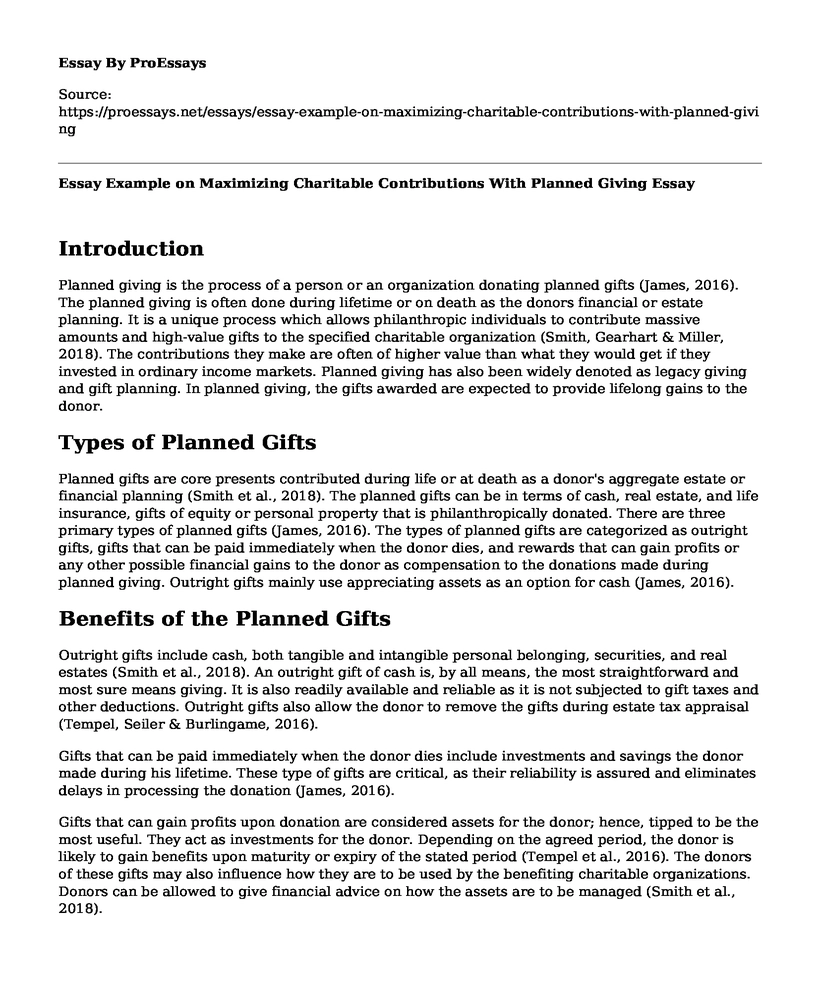Introduction
Planned giving is the process of a person or an organization donating planned gifts (James, 2016). The planned giving is often done during lifetime or on death as the donors financial or estate planning. It is a unique process which allows philanthropic individuals to contribute massive amounts and high-value gifts to the specified charitable organization (Smith, Gearhart & Miller, 2018). The contributions they make are often of higher value than what they would get if they invested in ordinary income markets. Planned giving has also been widely denoted as legacy giving and gift planning. In planned giving, the gifts awarded are expected to provide lifelong gains to the donor.
Types of Planned Gifts
Planned gifts are core presents contributed during life or at death as a donor's aggregate estate or financial planning (Smith et al., 2018). The planned gifts can be in terms of cash, real estate, and life insurance, gifts of equity or personal property that is philanthropically donated. There are three primary types of planned gifts (James, 2016). The types of planned gifts are categorized as outright gifts, gifts that can be paid immediately when the donor dies, and rewards that can gain profits or any other possible financial gains to the donor as compensation to the donations made during planned giving. Outright gifts mainly use appreciating assets as an option for cash (James, 2016).
Benefits of the Planned Gifts
Outright gifts include cash, both tangible and intangible personal belonging, securities, and real estates (Smith et al., 2018). An outright gift of cash is, by all means, the most straightforward and most sure means giving. It is also readily available and reliable as it is not subjected to gift taxes and other deductions. Outright gifts also allow the donor to remove the gifts during estate tax appraisal (Tempel, Seiler & Burlingame, 2016).
Gifts that can be paid immediately when the donor dies include investments and savings the donor made during his lifetime. These type of gifts are critical, as their reliability is assured and eliminates delays in processing the donation (James, 2016).
Gifts that can gain profits upon donation are considered assets for the donor; hence, tipped to be the most useful. They act as investments for the donor. Depending on the agreed period, the donor is likely to gain benefits upon maturity or expiry of the stated period (Tempel et al., 2016). The donors of these gifts may also influence how they are to be used by the benefiting charitable organizations. Donors can be allowed to give financial advice on how the assets are to be managed (Smith et al., 2018).
How the Organization Will Utilize the Different Types of Planned Gifts
The planned gifts are always a form of fundraising for charitable missions (James, 2016). In fulfilling the organization's goals and objectives, the planned gifts donated by the donors will all be directed to the proposed plans that led to the holding of the fundraising. My organization is a charitable non-governmental agency which deals with helping needy children in society achieve their dreams. The organization does not only focus on academic goals but also engages in nurturing young talents. The gifts donated will facilitate the acquisition of equipment to be used by the agency in promoting awareness about undiscovered talents among youths. It will also use part of the gifts to educate bright young children. The remaining funds will be invested for income earning projects to help sustain the organization and pay back the debts when demanded.
References
James III, R. N. (2016). Testing the effectiveness of fundraiser job titles in charitable estate and complex gift planning. Nonprofit Management and Leadership, 27(2), 165-179. Retrieved from https://www.google.com/url?sa=t&source=web&rct=j&url=https://pdfs.semanticscholar.org/a451/a0369f18b241b2245ef31d695d9a2c6d0440.pdf&ved=2ahUKEwiIooa4tObiAhWGx4UKHRLcBKoQFjAJegQICRAB&usg=AOvVaw38n45LZcLQkHFhSIUopyBY
Smith, E. A., Gearhart, G. D., & Miller, M. T. (2018). Planned Giving in Community College Development Efforts: Plans, Strategies, and Luck. Journal of Higher Education Theory and Practice, 18(2). Retrieved from https://www.google.com/url?sa=t&source=web&rct=j&url=http://ecommons.aku.edu/cgi/viewcontent.cgi%3Farticle%3D1050%26context%3Dbooks&ved=2ahUKEwiV-sKUtebiAhUvzoUKHc61DbAQFjADegQIAhAB&usg=AOvVaw1tA5xIE9HWFqaRRdSM3vY3u
Tempel, E. R., Seiler, T. L., & Burlingame, D. F. (2016). Achieving excellence in fundraising. John Wiley & Sons. Retrieved from https://www.google.com/url?sa=t&source=web&rct=j&url=https://leseprobe.buch.de/images-adb/a7/29/a729abba-d387-432d-9bb7-544dc2dbff7a.pdf&ved=2ahUKEwjG0sf_tebiAhVR6RoKHUe5D-IQFjAGegQIAxAB&usg=AOvVaw2nZQFizNDIMp5sMRsQYuww&cshid=1560427775934
Cite this page
Essay Example on Maximizing Charitable Contributions With Planned Giving. (2023, Jan 23). Retrieved from https://proessays.net/essays/essay-example-on-maximizing-charitable-contributions-with-planned-giving
If you are the original author of this essay and no longer wish to have it published on the ProEssays website, please click below to request its removal:
- Strategic Communication Plans Analysis
- Case Study on Financial Literacy
- Impact of Social Media to Society - Research Paper
- Essay Sample on Engaging in Social Work: Gaining Gratification Through Charity Work
- Essay Example on Reimagining Arts & Society: The Bauhaus Model of Pedagogy
- Exploring Group Dynamics: Norms, Roles, and Attitudes - Essay Sample
- Social Media Use - Essay Example







